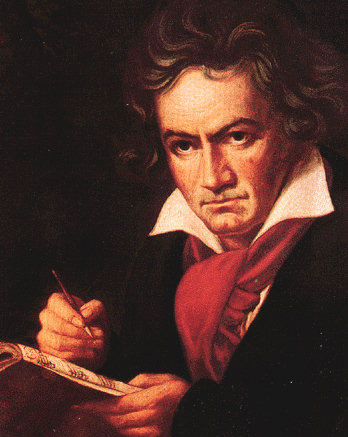|
||
|
The seventh symphony of Beethoven is a work of unceasing energy and drive. Its impetus is created not so much by the use of melody, but by rhythmic devices and harmonic inventiveness. Wagner described it as the apotheosis of the dance, and indeed the obsessive dotted rhythms of the first movement and the ritualistic forceful pounding of the finale seem to invite the listener to get up and dance. The symphony starts with a very long introduction - the longest of any of Beethoven's symphonies. It uses the simplest of melodic ideas, but gains excitement by moving through a succession of unconventional keys. These seem quite natural to modern ears, but at the time sounded strange and incongruous, prompting Carl Maria von Weber to declare that "Beethoven is fit for the madhouse". The transition into the main part of the first movement is an example of the many innovations in the symphony. For nine bars we hear just one note E, being quietly tossed around the orchestra, until finally the flute extends it into the glorious theme of the main movement, which follows the conventional sonata form outline, and is remarkable in its sparsity. Almost all the melodic material derives from the dotted dance-like tune introduced by the flute, and as in the introduction the harmonies take us to unusual keys such as F major and C major. After a slightly subdued and brooding opening to the coda Beethoven brings the movement to a glorious finish crowned by the horns at the top of their range. The second movement is an Allegretto replacing the more conventional slow movement. It provides a complete contrast to the first and subsequent movements and is in the minor mode. The first section begins with a very simple melody, played at first on the low strings, then moving up to the violins while gradually getting louder and more assured until it is taken up, forte, by the whole orchestra. A much gentler middle section follows in the key of A major, then the first theme returns, but surrounded by different textures, and visiting more remote keys. A short reminder of the A major section brings the movement to the coda, where the first theme appears in fragments passed around the orchestra. At the first performance this movement was so loudly applauded that it was played for a second time. It remains one of the most famous of all Beethoven's compositions. The third movement is a scherzo and trio, with the scherzo in the key of F major, echoing the use of that key in the first movement, and the trio in the key of D major, much closer to the home key of A. The scherzo is filled with boundless energy moving at a furious pace, whereas the trio is very static, with a long drone note in the violins and a chorale like passage for the wind instruments. Beethoven extends the form by playing the trio twice, and after the third playing of the scherzo he playfully begins the trio - as if for a third time - but then quickly closes the movement with five fast dramatic chords. Two fortissimo chords open the last movement which launches immediately into an energetic dance in duple time with an insistent pounding beat. There is no let-up in the driving intensity. There are contrasts of dynamics and a distinctly different second melody, but the movement surges on seemingly unstoppable. There is not even the trace of a pause as it moves into the coda with a dramatic lurch to the relative minor. But here there is a sinister moment as the rushing semiquavers subside a little, the wind instruments play long sustained chords and we clearly hear the bass line sinking as if in despair. The moment is short-lived, the music rallies and we return to the home key in a blaze of energy. Here the triple forte indication is used for the first time in any symphony. The symphony was completed in 1812, but the premiere did not take place until 8 December 1813 at a charity concert for soldiers wounded in the Battle of Hanau. It was a patriotic occasion, particularly as Vienna had been twice occupied by the French, but it seemed that Napoleon was on the edge of defeat. Despite his increasing deafness Beethoven conducted the performance. Louis Spohr who was present described the energy with which he directed the orchestra: "as a sforzando occurred, he tore his arms asunder with great vehemence, at the arrival of a forte he jumped in the air". The premiere was a triumph for Beethoven and ever since the symphony has been regarded as one of the greatest ever written. Beethoven's seventh symphony was performed by the Portobello Orchestra on the 7th July 2018, conducted by Sam Jones. back |

